Flounder Fishing in Texas
Leslie Williams, Dickinson Marine Lab, Dickinson Texas
Because of its delicious taste, flounder is one of the top three fish targeted by anglers in Texas bays. However, flounder provide a unique challenge to the Texas angler, because if you go out a week too soon or too late, you could miss the big flounder run. So, if you travel the Texas coast after the first winter cold front comes through you can see many fishermen clustered around passes braving the cold weather, looking for the big run of flounder into the Gulf of Mexico.
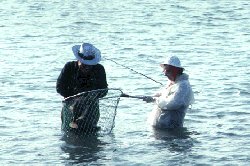
Many fishermen can remember the old flounder runs and think that the runs now just aren't what they used to be. It is true that flounder populations have decreased since the late 70’s measured by the catch per hour of flounder collected in Texas Parks and Wildlife gill net surveys. However, bag seine catch rates show that recruitment, or influx of young-of-the-year flounder, has been fairly steady over time. The decreasing population trend despite steady recruitment indicates that fishing mortality is most likely the cause of the population decrease. During the early 1980's red drum and spotted seatrout were given game fish status, which unfortunately also resulted in increased fishing pressure on flounder. Bycatch of young flounder in the shrimp trawl fishery has also had a negative impact on flounder populations.
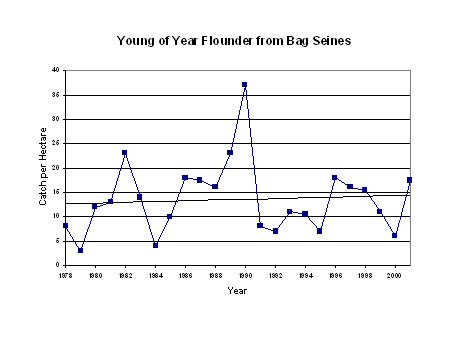
In order to try to counter declines in the flounder population, Texas Parks and Wildlife has implemented a number of management changes. In the late 1980's commercial netting was banned. The shrimp limited entry program, started in 1995, should also reduce flounder bycatch and benefit flounder populations. Flounder size and bag limits were also implemented – with the latest occurrence in 1998. As shown by the dotted line in the gill net chart, the flounder population has stabilized since these changes and has not experienced a significant decrease since then. While this is a good indication that flounder populations might be improving, Texas Parks and Wildlife will continue to assess flounder status.
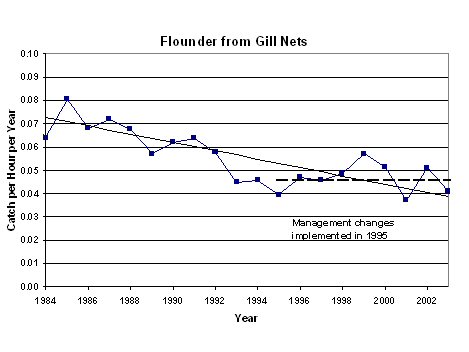
The southern flounder is the largest flounder in the Gulf of Mexico and can be found from North Carolina to Mexico partly because they can tolerate a wide range of temperatures and salinities. They are laterally compressed (flat) with both eyes on their left side. A similar fish, the sole, has their eyes on the right side. They are typically found in areas with silt and clay bottoms, where they are known for being able to blend in with their background. Southern flounder have light spots or blotches on their left side, which tend to disappear, as the flounder grows larger. In rare cases the flounder can have color on its blind right side or be an albino.
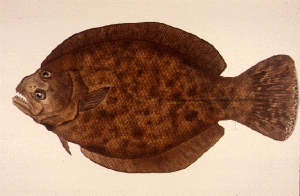
In the fall, adult flounder migrate from the bays to the Gulf to spawn. Males leave for the Gulf when the water temperature drops 4o to 5oC, usually before the females. A severe cold front will cause a mass migration resulting in large catches, while a moderate winter will spread out the departure of the larger flounder over a longer period of time. Studies have shown that between spawning migrations, flounder only move a short distance and typically return to the same bay they came from.
Flounder spawn offshore in waters between 30-66 meters (98-217 feet) deep when they reach 2 years of age. Young flounder that do not migrate to the Gulf, spend the winter in deep holes and channels. Each female can spawn up to 13 times a season and can produce around 29,000 eggs per spawn. Females release their eggs into the currents and the males then fertilize the eggs. After the eggs hatch, flounder larvae are symmetrical with their eyes on both sides of their body. As the flounder grows in size the right eye migrates to the left side of its head. When the flounder reaches half an inch in length, the eye has finished its migration. Larval and juvenile flounder drift with the currents into the bays and estuaries in the spring. Postlarval flounder seek out lower salinity areas in the spring but return to higher salinity offshore areas in the winter as they approach one year in age and nearly a foot in length. The current minimum size for a keeper flounder is 14 inches with no maximum size limit. Female flounder are larger than male flounder of the same age. Due to their larger size, female flounder are usually the ones caught by fishermen.
Juvenile flounder feed on bottom invertebrates and fish but as they grow in size the amount of fish in their diet increases. Their large mouths with strong teeth allow them to feed on other fish, shrimp, and bottom dwelling invertebrates. Flounder are an ambush predator, which will burrow into the mud bottom and lay in wait for other fish to swim within striking distance.
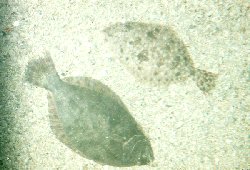
The best time to catch flounder is during their fall migration to the Gulf, typically from October to December, in the channels and passes leading to the Gulf. Flounder may be caught using rod and reel but most people prefer gigs. The current state record for a Southern flounder was caught in the Gulf of Mexico in December 2002 by gig weighed 14.5 pounds, 34.5 inches long. The world record was just shy of 21 pounds and was caught in Florida in December 1983. With continued management, fishermen can brave the first cold front of winter and catch a nice flounder for supper for years to come.
© Copyright Texas Parks and Wildlife Department. No part of this work may be copied, reproduced, or translated in any form or medium without the prior written consent of Texas Parks Wildlife Department except where specifically noted. If you want to use these articles, see Site Policies